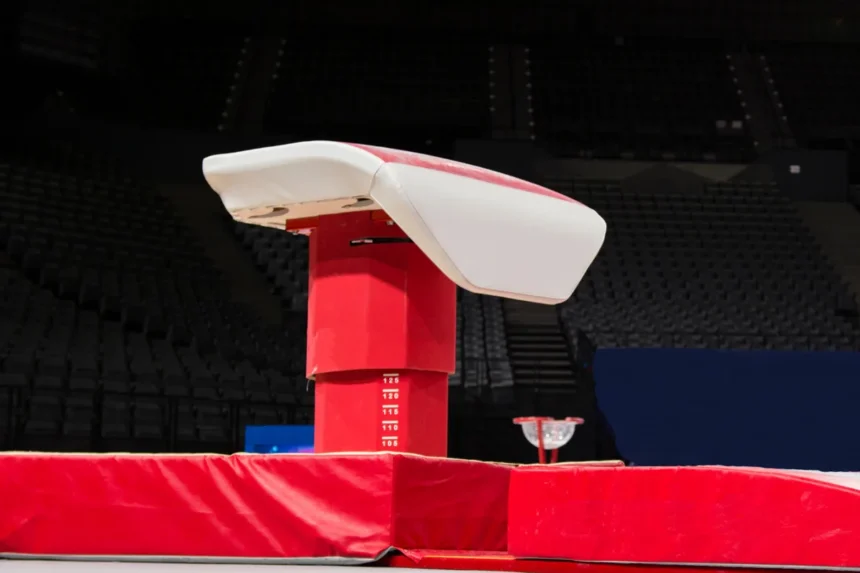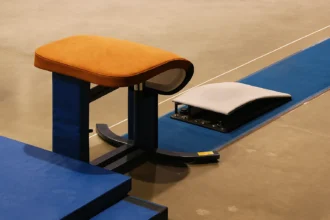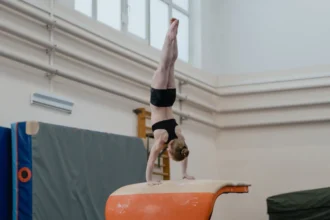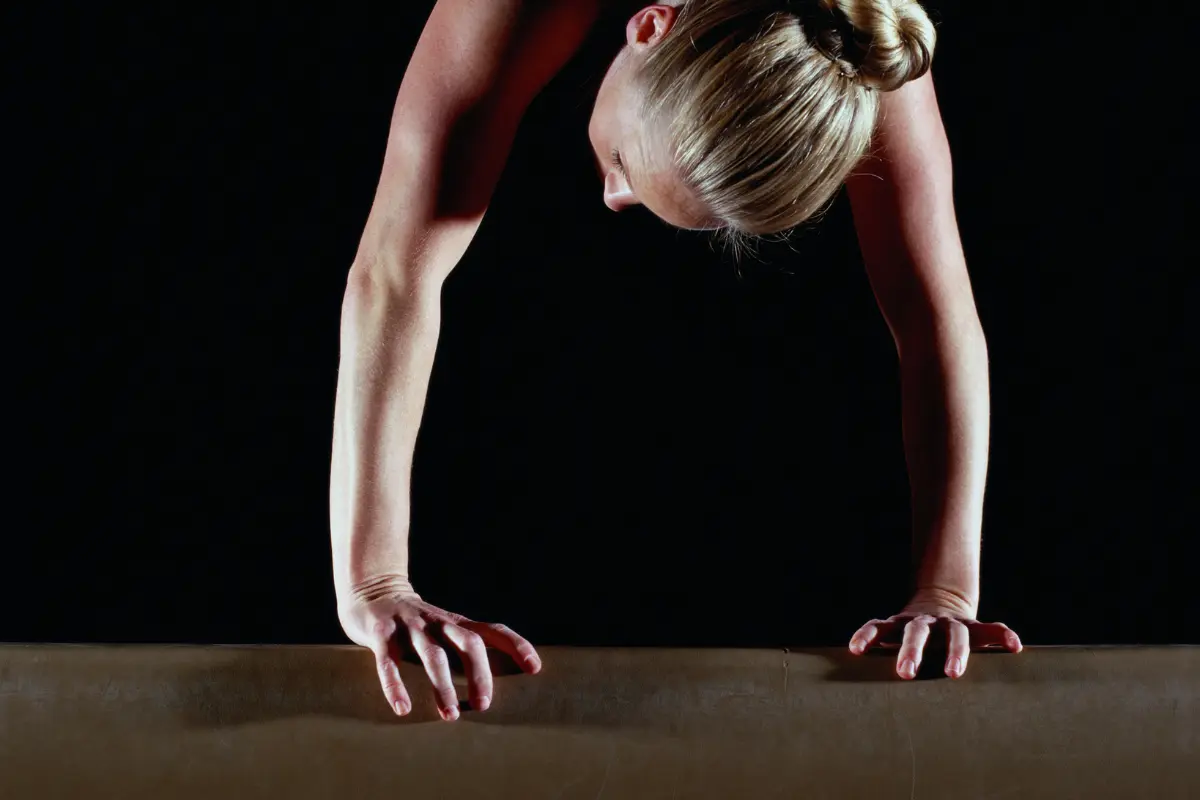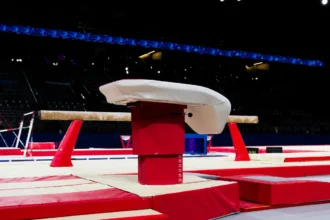In artistic gymnastics, vault is one of the most thrilling events—over in just a few seconds, but packed with speed, height, and difficulty. What makes vault unique is that every skill fits into one of six recognized families in the FIG Code of Points. These families are grouped by entry style, the way the gymnast approaches and contacts the vault table.
1. Handspring Family (Front Handspring)
The Handspring Family is the cornerstone of gymnastics vaulting. It begins with a powerful sprint, a forward takeoff from the springboard, and a front handspring onto the vault table, usually leading into a forward salto or twist. Simple yet essential, it teaches the mechanics of speed, blocking, and body alignment that underpin every other vault family.
Phases of the Vault
Vault specialists often break the handspring into phases to highlight where energy is created and redirected. According to GymnasticsHQ, the handspring vault can be divided into five distinct stages:
- Run & Pre-Flight – A fast sprint and low hurdle into an explosive punch off the springboard, keeping a tight, angled body for momentum.
- Support (On Table) – A quick, straight-body handstand position, blocking off the table at roughly 20–30° above horizontal.
- Post-Flight – The upward and outward flight phase that sets up flips or twists.
- Landing – Executed with control, absorbing force through bent knees while maintaining posture.
Biomechanical studies refine this even further into seven phases: approach run, takeoff, board contact, first flight, repulsion (block), post-flight, and landing—offering a detailed framework for coaches analyzing vault performance.
Why It Endures
Even as gymnasts push difficulty with Yurchenkos, Chengs, and other complex entries, the front handspring endures as the foundation of vault training. Its simplicity makes it accessible to beginners. In short, every vault career begins here.
2. Tsukahara Family (¼–½ Turn Pre-Flight)
The Tsukahara Family is named after Japanese Olympic champion Mitsuo Tsukahara, who first performed this entry in the 1970s. The gymnast performs a round-off onto the springboard, then adds a quarter- to half-turn before placing their hands on the vault table facing backward. This redirection sets up powerful backward saltos, often with twists.
Phases of the Vault
While the same biomechanical stages apply as in the handspring, the Tsukahara introduces a critical pre-flight twist:
- Run & Hurdle – A sprint into a round-off, ensuring tight alignment and speed.
- Board Contact – The gymnast punches the board while already rotating into the quarter- or half-turn.
- Pre-Flight – The twist finishes as the hands reach for the table, entering in a backward-facing position.
- Support (On Table) – Strong blocking mechanics redirect the gymnast upward and backward.
- Post-Flight & Landing – Twisting saltos are completed in the air before a controlled landing.
Historical Impact
When Tsukahara debuted this vault, it redefined what was possible on the event. For the first time, gymnasts could combine a twisting entry with backward saltos, dramatically raising the ceiling of vault difficulty.
3. Yurchenko Family (Round-Off → Back Handspring)
The Yurchenko Family is named after Soviet gymnast Natalia Yurchenko, who first performed the entry in 1982. It begins with a round-off onto the springboard, followed immediately by a back handspring onto the vault table, where the gymnast blocks explosively into the post-flight phase. This entry quickly became the most influential vault style in women’s gymnastics and remains the dominant choice at the elite level.
Phases of the Vault
The Yurchenko follows the same biomechanical stages as other families but adds the distinctive back handspring pre-flight:
- Run & Round-Off – A fast approach that finishes in a round-off, positioning the gymnast backward on the springboard.
- Board Contact – A two-footed punch upward, setting up the back handspring.
- Back Handspring Onto Table – The gymnast flips into a handstand-like position on the vault table, shoulders open and ready to block.
- Block (Support Phase) – A powerful shoulder push generates height and rotation unmatched by other entries.
- Post-Flight – Twists and saltos are executed with ample airtime.
- Landing – A controlled, upright finish with knees bent to absorb impact.
Legacy
When Yurchenko debuted her entry, it was considered nearly impossible. Today, it is the gold standard of women’s vaulting. Nearly every Olympic vault champion of the modern era has relied on a Yurchenko entry, and its influence has reshaped vault training worldwide.
4. Round-Off Half-On Family (Cheng/Rudi)
The Round-Off Half-On Family builds on the round-off entry but replaces the back handspring of the Yurchenko with a half-turn onto the vault table. This reorients the gymnast so they leave the table facing forward, setting up spectacular forward-facing twisting saltos. It’s the family behind some of the most famous modern vaults, including the Cheng and Rudi.
Phases of the Vault
- Run & Round-Off – The gymnast approaches with speed and precision, finishing a round-off onto the board.
- Board Contact – The punch is timed with the start of a half-turn.
- Half-On to Table – The gymnast rotates ½ turn onto the table, contacting it sideways or forward-facing.
- Block (Support Phase) – Shoulders extend upward to generate lift while redirecting forward.
- Post-Flight – The gymnast performs twisting forward saltos (layouts or pikes).
- Landing – Controlled touchdown, absorbing impact and keeping the chest upright.
Notable Examples
- Cheng – Round-Off Half-On with a Layout 1.5 twist off; performed by Olympic champions like Cheng Fei (its namesake) and Simone Biles.
- Rudi – Round-Off Half-On with a Layout 1.5 salto; another elite-level staple.
Legacy
This family has become a cornerstone of women’s elite gymnastics, often paired with Yurchenkos to show variety in vault finals. The Cheng, in particular, remains one of the most difficult and frequently performed high-value vaults in the Code of Points.
5. Cuervo Family
The Cuervo Family is another round-off–based entry, but instead of the Yurchenko’s back handspring or the Cheng’s half-on, the gymnast performs a half-turn onto the vault table leading directly into a front salto off. This redirection produces distinctive forward-facing flips and twists, making it a rare but creative vault family in competition.
Phases of the Vault
- Run & Round-Off – A strong sprint into a round-off onto the springboard, facing backward.
- Board Contact – Punch upward while initiating a half-turn.
- Half-On to Table – Hands contact the table forward-facing.
- Block (Support Phase) – Push explosively through the shoulders to redirect momentum upward.
- Post-Flight – A forward salto, often with twists, in layout or pike.
- Landing – A clean, controlled finish, chest upright with bent knees to absorb impact.
Why It Matters
Although less frequently performed at the elite level, the Cuervo family shows how entry mechanics create different vault pathways. It offers variety, scoring opportunities, and creative expression in the Code of Points.
6. Arabian and Other Legacy Entries
The Arabian and Legacy Vault Family is a collection of vaults that don’t fit neatly into the other five families. These include entries with a half-turn into backward saltos (Arabian-style) or quarter-turn approaches that result in sideways entry. Once common, they are now rare at the elite level.
Phases of the Vault
- Run & Approach – A sprint into the hurdle, often with an early twist.
- Board Contact – Punch while initiating a half- or quarter-turn.
- Pre-Flight Entry – Arabian-style half-turn into a back salto setup, or quarter-turn entry sideways to the table.
- Block (Support Phase) – Push off the table to redirect into the salto.
- Post-Flight – Flips, twists, or backward rotations.
- Landing – A stable finish, often harder to control given the unusual entry paths.
Historical Note
Arabian and quarter-turn vaults were more common before the modern vault table was introduced in 2001. Though legacy vaults have faded, their role in innovation and technique development remains important.
Vault Family Summary Chart
| Vault Family | Entry Mechanics | Famous Vaults | Best Known For |
|---|---|---|---|
| Handspring (Front Handspring) | Sprint → punch board → front handspring onto table | Handspring Front Pike, Produnova | The foundation of vaulting; builds blocking and body control |
| Tsukahara (¼–½ Turn Pre-Flight) | Round-off → board → quarter/half-turn → contact backward | Tsukahara Layout, Kasamatsu | Introduced backward saltos with twists; staple in MAG |
| Yurchenko (Round-Off → Back Handspring) | Round-off → board → back handspring onto table → block | Amanar (2.5 twists), Biles II | Dominant WAG entry; unmatched height and twisting potential |
| Round-Off Half-On (Cheng/Rudi) | Round-off → board → half-turn onto table → forward exit | Cheng, Rudi | High-value forward vaults; elite medal-decider |
| Cuervo | Round-off → board → half-turn onto table → front salto | Cuervo Layout, Cuervo 1.5 | Less common; creative forward-facing vaults |
| Arabian / Legacy | Half/quarter-turn entries with backward saltos or sideways approaches | Arabian Vaults | Historically important; now rare but pioneered creativity |
Timeline of Vault Family Evolution
- 1970s – Tsukahara Revolution
Japanese gymnast Mitsuo Tsukahara debuts the round-off with a quarter-turn entry, unlocking backward saltos with twists. - 1982 – The Yurchenko Era Begins
Soviet gymnast Natalia Yurchenko introduces the round-off → back handspring entry, reshaping women’s vaulting forever. - 1990s – Expanding Difficulty
Variations like the Kasamatsu and double-salto vaults become standard in men’s gymnastics, while women push twisting Yurchenkos. - 2001 – Vault Table Introduced
FIG replaces the narrow vaulting horse with the modern vault table, increasing safety and making entries like the Yurchenko and Cheng more practical. - 2010s – The Amanar Era
The Amanar (Yurchenko 2.5 twists) becomes a must-have vault for Olympic medal contention in women’s gymnastics. - 2021 – Simone Biles Debuts the Biles II
At the U.S. Classic, Biles lands the Yurchenko Double Pike, the most difficult women’s vault ever performed. - Today – Six Families, Endless Possibilities
Gymnasts specialize across the six vault families—Handspring, Tsukahara, Yurchenko, Round-Off Half-On, Cuervo, and Arabian/Legacy—keeping variety alive while pushing difficulty to new heights.
Today’s gymnasts may specialize in Chengs, Amanars, or Produnovas, but all of these vaults trace back to the family system that organizes the event.


